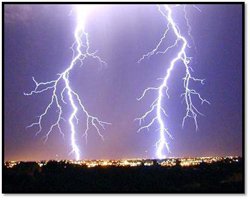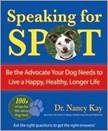Thunder Struck
by Nancy Kay, DVM
 When we moved from California six months ago, I suspected that our two dogs, Nellie and Quinn, might not take kindly to the frequent thunderstorms we would experience in the mountains of North Carolina. My hunch was accurate. While I was enjoying the late afternoon rockin’ and a rollin’ my two little pumpkins were experiencing a whole lot of shakin’ and quakin’! Left to her own devices, I sense that Nellie would not be bothered by the thunder, but her best buddy Quinn’s panting, yawning, trembling, and clingy behavior were clearly a bit contagious.
When we moved from California six months ago, I suspected that our two dogs, Nellie and Quinn, might not take kindly to the frequent thunderstorms we would experience in the mountains of North Carolina. My hunch was accurate. While I was enjoying the late afternoon rockin’ and a rollin’ my two little pumpkins were experiencing a whole lot of shakin’ and quakin’! Left to her own devices, I sense that Nellie would not be bothered by the thunder, but her best buddy Quinn’s panting, yawning, trembling, and clingy behavior were clearly a bit contagious.
I needed help and sought advice from colleagues who specialize in dog training and behavior. They had several good suggestions for riding out the storm with a thunder-phobic dog.
Here’s what I’ve done thus far to alleviate Quinn’s thunder-phobia which has, in turn, markedly reduced Nellie’s anxiety. Quinn wears a pheromone collar and when thunderstorms are in the forecast, I give him a morning dose of melatonin. These tactics combined with use of a Thundershirt® and my consciously calm behavior seem to be turning the tide for my “thunder-struck” little boy.
Is your dog fearful of thunder? If so, what have you tried and how has it worked? If you happen to be a dog trainer or behaviorist, I hope you will chime in with your experiences.
CREDIT:
Dr. Nancy Kay, DVM Diplomate, American College of Veterinary Internal Medicine.
Recipient, American Animal Hospital Association 2009 Animal Welfare and Humane Ethics Award Recipient, 2009 Dog Writers Association of America Award for Best Blog Recipient, 2009 Eukanuba Canine Health Award
 Author of Speaking for Spot: Be the Advocate Your Dog Needs to Live a Happy, Healthy, Longer Life
Author of Speaking for Spot: Be the Advocate Your Dog Needs to Live a Happy, Healthy, Longer Life
Website: http://speakingforspot.com
Spot’s Blog: "http://www.speakingforspot.com/blog
Email: dr.kay@speakingforspot.com
Become a Facebook Fan: Facebook Fan - Nancy-Kay
 When we moved from California six months ago, I suspected that our two dogs, Nellie and Quinn, might not take kindly to the frequent thunderstorms we would experience in the mountains of North Carolina. My hunch was accurate. While I was enjoying the late afternoon rockin’ and a rollin’ my two little pumpkins were experiencing a whole lot of shakin’ and quakin’! Left to her own devices, I sense that Nellie would not be bothered by the thunder, but her best buddy Quinn’s panting, yawning, trembling, and clingy behavior were clearly a bit contagious.
When we moved from California six months ago, I suspected that our two dogs, Nellie and Quinn, might not take kindly to the frequent thunderstorms we would experience in the mountains of North Carolina. My hunch was accurate. While I was enjoying the late afternoon rockin’ and a rollin’ my two little pumpkins were experiencing a whole lot of shakin’ and quakin’! Left to her own devices, I sense that Nellie would not be bothered by the thunder, but her best buddy Quinn’s panting, yawning, trembling, and clingy behavior were clearly a bit contagious.I needed help and sought advice from colleagues who specialize in dog training and behavior. They had several good suggestions for riding out the storm with a thunder-phobic dog.
I encourage you to consult with your veterinarian and a reputable trainer or behaviorist as part of your dog’s thunder desensitization program. Also know that the techniques described above can be utilized for most any noise phobias (fireworks, shotgun blasts, etc.).Step number one is to pay close attention to weather forecasts and know when thunderstorms are likely to roll in. Anti-anxiety strategies are far more effective when implemented before rather than after Mother Nature’s “music” begins. Provide a “safe place” for your dog to ride out the storm. Ideally, this is a small, dark space such as a crate (door left open) or an enclosed room with curtains drawn along with a radio or stereo playing to drown out the sound of the thunder. Acclimate your dog to this environment. It will help if he associates this special spot with special treats or a food-dispensing toy. The Thundershirt® is a tight fitting wraparound body shirt designed to apply gentle, constant pressure to the dog’s torso. This contact is intended to reduce anxiety and fearfulness. Researcher Temple Grandin believes that such “body enclosure” has a profoundly calming effect. Desensitization is another option in which a recording of thunder sounds is initially played at a low enough volume that it does not appear to cause any fear or anxiety for the dog. The volume of the recording is very slowly increased over time until the dog no longer responds to the sound, even when loud enough to mimic real thunder. Add to this desensitization some counter-conditioning in which the dog receives something cherished (tug-of-war, food treats, brushing, tummy rub) while the thunder recording is playing, and he will hopefully begin to react to the real thing with pleasant associations rather than distress. Pheromone sprays and collars are safe and relatively inexpensive and may reduce thunder-associated anxiety. Natural supplements such as L-theanine (an amino acid found in tea leaves) and melatonin (a naturally occurring hormone) may decrease anxiety in response to thunder. Medications that reduce anxiety (anxiolytics) may be of benefit. Benzodiazepine drugs, such as Valium and Xanax, are potent anxiolytics when used at the lower end of the dosage range. At higher dosages they tend to cause sedation. After consultation with your veterinarian, a “practice dose” or two should be tested independent of a storm to find the appropriate dose for your dog. Acepromazine, a commonly prescribed tranquilizer for dogs, is not recommended because it causes sedation but does not significantly reduce anxiety. Easier said than done, but do your best to relax and behave as if everything is completely normal during the course of a storm. Any anxiety on your part will be contagious to that mind-reading four-legged companion of yours.
Here’s what I’ve done thus far to alleviate Quinn’s thunder-phobia which has, in turn, markedly reduced Nellie’s anxiety. Quinn wears a pheromone collar and when thunderstorms are in the forecast, I give him a morning dose of melatonin. These tactics combined with use of a Thundershirt® and my consciously calm behavior seem to be turning the tide for my “thunder-struck” little boy.
Is your dog fearful of thunder? If so, what have you tried and how has it worked? If you happen to be a dog trainer or behaviorist, I hope you will chime in with your experiences.
CREDIT:
Dr. Nancy Kay, DVM Diplomate, American College of Veterinary Internal Medicine.
Recipient, American Animal Hospital Association 2009 Animal Welfare and Humane Ethics Award Recipient, 2009 Dog Writers Association of America Award for Best Blog Recipient, 2009 Eukanuba Canine Health Award
 Author of Speaking for Spot: Be the Advocate Your Dog Needs to Live a Happy, Healthy, Longer Life
Author of Speaking for Spot: Be the Advocate Your Dog Needs to Live a Happy, Healthy, Longer LifeWebsite: http://speakingforspot.com
Spot’s Blog: "http://www.speakingforspot.com/blog
Email: dr.kay@speakingforspot.com
Become a Facebook Fan: Facebook Fan - Nancy-Kay
